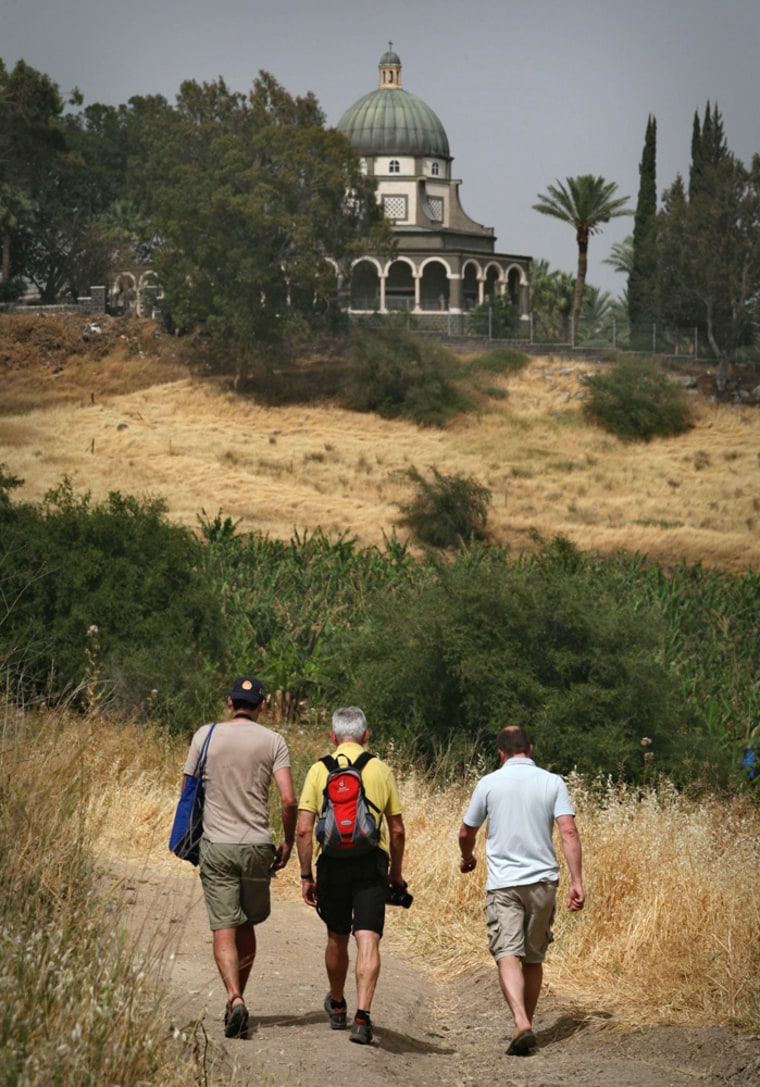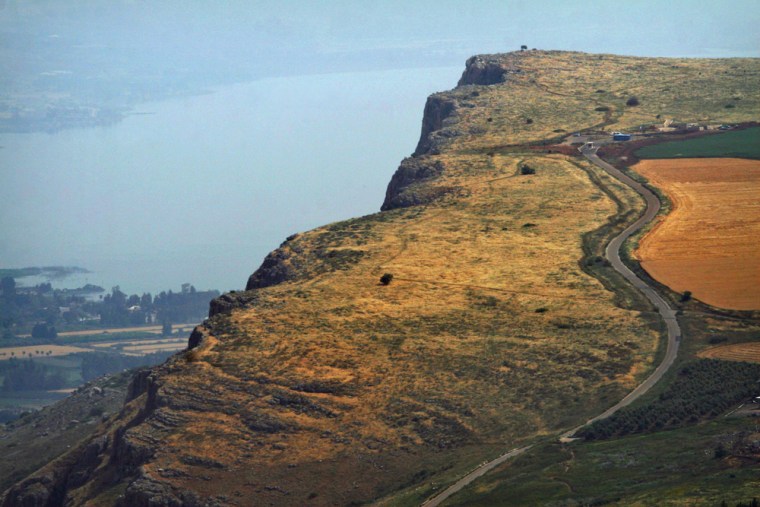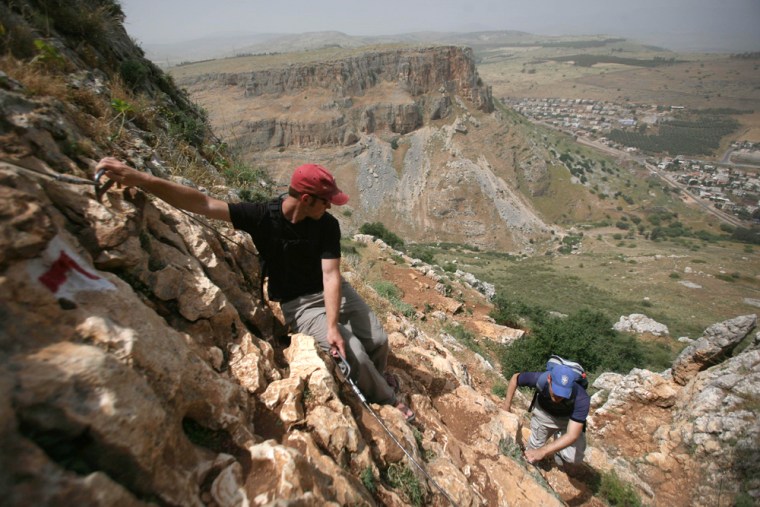A dirt path begins across the road from a bus-congested holy site on Israel's Sea of Galilee, winding up a hill covered with wild oat and thistle.
Thousands of pilgrims each year visit the stone church at Tabgha and other sanctuaries marking Jesus' miracles. But few venture beyond the crowds to the landscape Jesus walked in Galilee. Those who do find silence and solace on the rocky hills and in the shade of the olive trees that cover the plains.
Now a private Israeli project has set down a 40-mile hiking path through the region where Jesus ministered. The Jesus Trail hopes to bring thousands of tourists to follow in his footsteps to hear the songbirds, smell the wild dill and reflect along the way.
Since the trail is not yet marked, travelers can hire a tour guide, download GPS coordinates from Jesustrail.com or pick up trail maps at tourist sites. The path is meant to be hiked in four days. Pilgrims can sleep near the start of the trail in Nazareth, the town Jesus lived in as a boy, and travel each day to the start of a section. Or they can stay at the occasional guest house offered by kibbutzim and Arab communities or carry tents with them.
The path is an alternative to bus tours that stop only at the known holy sites.
"I think the trail more than anything brings out the human nature of Jesus when the Bible talks about him becoming flesh and living among the people," said David Landis, an American who has helped lay out the trail. "I meet the people and I travel the land and I see the flowers and the wildlife, the real things ... that really come alive for me in the story."
My hike in April with Landis and the Israeli brain behind the endeavor, entrepreneur Maoz Inon, began before sunup in Nazareth at the Fauzi Azar Inn, a hostel in a 200-year-old Arab mansion that Inon manages in Nazareth's Old City.
I awoke to the sound of the call to prayer from several mosques combined with the lively screeching of swifts as they darted over the brightening sky. Bells soon began to ring at the Church of the Annunciation, calling believers to Sunday worship at the sanctuary where tradition says God told Mary she would give birth to his son.
We alternated between foot and Inon's car since we had to fit the entire trip into one day.
Starting by car, our first stop was the Arab village of Kana, about nine miles into the trail. At the 19th-century Wedding Church commemorating Jesus' miracle here of changing water into wine at a wedding, we met a swarm of tourists from Georgia, Alabama and Ohio.

Standing in the church's cobblestone yard, group leader David Hughes, a pastor, pointed out that the stone structure, like any trail purporting to follow ancient travels, cannot be proven as a place that Jesus actually visited. But even without definitive historic sites, Hughes said he could see why pilgrims would find it meaningful to hike in an area like the Galilee, and soak up the landscape.
"You get the more reflective, meditative, you know, looking-in type aspect of your relationship with Jesus by taking that walk," said Hughes, of Rutledge, Ga. "The more intimate you become with the land, the more the land becomes intimate to you, the smells, the feel, the hills."
Israeli tour guide Yuval Sharon has led Christian groups along a route that differs slightly from the Jesus Trail. But Sharon says that for visitors to the Galilee "it's most important that they walk like Jesus did and don't travel in a car, even if it's not exactly the same path that Jesus followed."
Inon says the eventual goal is to mark the trail, in coordination with Israeli authorities. Israel's Tourism Ministry says it is developing its own trail but has not yet set it down. The ministry did not rule out cooperation with Inon, saying it promotes various Christian trails. Another effort by Harvard University's Global Negotiation Project, the Abraham Path, aims to mark trails following in the prophet's footsteps, a total of 750 miles from Turkey to his tomb in the West Bank city of Hebron.
From Kana we drove to the base of the Horns of Hittin, twin hills where it is believed the Muslim armies under Saladin conquered the Crusaders in a battle in 1187. Under an already-scorching sun at midmorning (bring lots of sunscreen and water!) we climbed a rocky path to the top where we sat on lichen-covered boulders under olive trees.
The natural beauty of the place is breathtaking, irrespective of your religious background. A delicate breeze cooled us off as we gazed at the quilt of square plots of peach orchards and vineyards surrounding the Sea of Galilee about 900 feet below.
From here we walked down through fields of wheat bobbing in the wind to a limestone mosque, a holy site for the Druse, an offshoot of Islam. We traveled by car to a thicket of Queen Anne's Lace flowers and thistles near the Arbel cliffs.

Here a path leads to the ruins of the 4th-century Arbel synagogue. A family vacationing nearby had stopped to see the place; their poodle paid no mind to the lizards skittering over the ancient stones.
"We are not religious people, but we feel something, something historical at this site," said Olga Dashevsky.
"I feel that the view is the same as it was 1,000 years ago," said her daughter, Victoria Dashevsky.
The trail leads down to the edge of the Arbel cliffs overlooking the Sea of Galilee and offers a view of many sites in Jesus' story, including Capernaum, the site of the fishing village that was center of Jesus' life and ministry.
Soon Landis, a 25-year-old graduate of Eastern Mennonite University in Virginia, was scaling the face of the cliffs, leading the way through caves and down the trail. Ladders and ropes make this most treacherous — albeit beautiful — part of the route passable for novice hikers.
We drove along the edge of the Sea of Galilee and then up to the Mount of Beatitudes where Christians believe Jesus made his Sermon on the Mount to followers on the shores below. A couple of travelers sat in the shade of eucalyptus trees outside the church that marks the site. Nearby a trail leads down to the lake, which provides almost half of Israel's drinking water.
Turning down the mount, we passed near banana and pear trees and soon met three Austrians hiking up from the Tabgha holy site where it is believed Jesus performed the miracle of fish and bread to feed the multitudes.
Out of breath and red-faced, Frank Pfeferle, one of the Austrians, said he believed that Jesus could have traveled the same path he was walking.
"I think not too much has changed in the 2,000 years here," said Pfeferle, "and that's why it's so interesting here."
